GRATIS
Acerca de este curso
- The Second Era of the Internet
- The Internet connects billions of people around the world, and is great for communicating and collaborating online. However, because it was built for moving and storing information, and not value, it has done little to change the way we do business. Now, for the first time in human history, two or more parties anywhere in the world can transact and do business peer to peer using the blockchain. In this module we introduce blockchain as “the trust protocol,” and explain how it represents the second era of the Internet. We describe how blockchain technology establishes trust—not through powerful intermediaries, but rather through collaboration, cryptography and clever code.
- Blockchain Design Principles
- We believe that the next era of the digital economy can be shaped around a set of blockchain design principles, which can be used for creating software, services, reinventing business models, markets, organizations, and even governments. This module frames the blockchain revolution around seven design principles. For each principle we describe a current problem to be solved, identify “blockchain breakthroughs” to these problems, and discuss the implications of these breakthroughs on the digital economy. We hope that these design principles will assist learners in contemplating their roles and their futures in the blockchain revolution.
- Public and Private Ledgers
- The advent of blockchain technology forces us to reconsider the upside and downside of public revelation of transactions and contracts. The implementation, application, and possible regulation of distributed ledgers involve choices that will critically affect information disclosure and economic interactions. Whether the ledger is public and permissionless, such as the Bitcoin or Ethereum blockchains, or private and permissioned, such as the Ripple or Hyperledger implementations, in principle transactions on a blockchain have a high native level of transparency. In this module, you will learn how privacy can can be protected in both public and private ledgers using both procedural and technological methods.
- The Blockchain Ecosystem
- Although blockchain technology emerged from the open source community, it quickly attracted many stakeholders, each with different backgrounds, interests, and motives. In this module, you will explore the roles and perspectives of nine categories of stakeholders within the blockchain ecosystem, including industry pioneers, venture capitalists, developers, governments, regulators, leaders, and end users.
- Blockchain Implementation Challenges
- Like every revolutionary technology, the blockchain has its upside and its downside. In this module we discuss ten implementation challenges which must be overcome as we transition to the second era of the Internet. For each challenge, you will also learn about potential solutions and what we can do to ensure the fulfillment of the blockchain’s promise.
Cursos relacionados

GRATIS Aprendiendo a aprender: Poderosas herramientas mentales…
Deep teaching solutions
Español

GRATIS Programación para todos (Introducción a Python)
University of Michigan
Inglés

GRATIS The Science of Well-Being
Yale
Inglés

GRATIS Negociación exitosa: Estrategias y habilidades esenciales
University of Michigan
Inglés

GRATIS Primeros Auxilios Psicológicos (PAP)
Universitat Autónoma de Barcelona
Español



